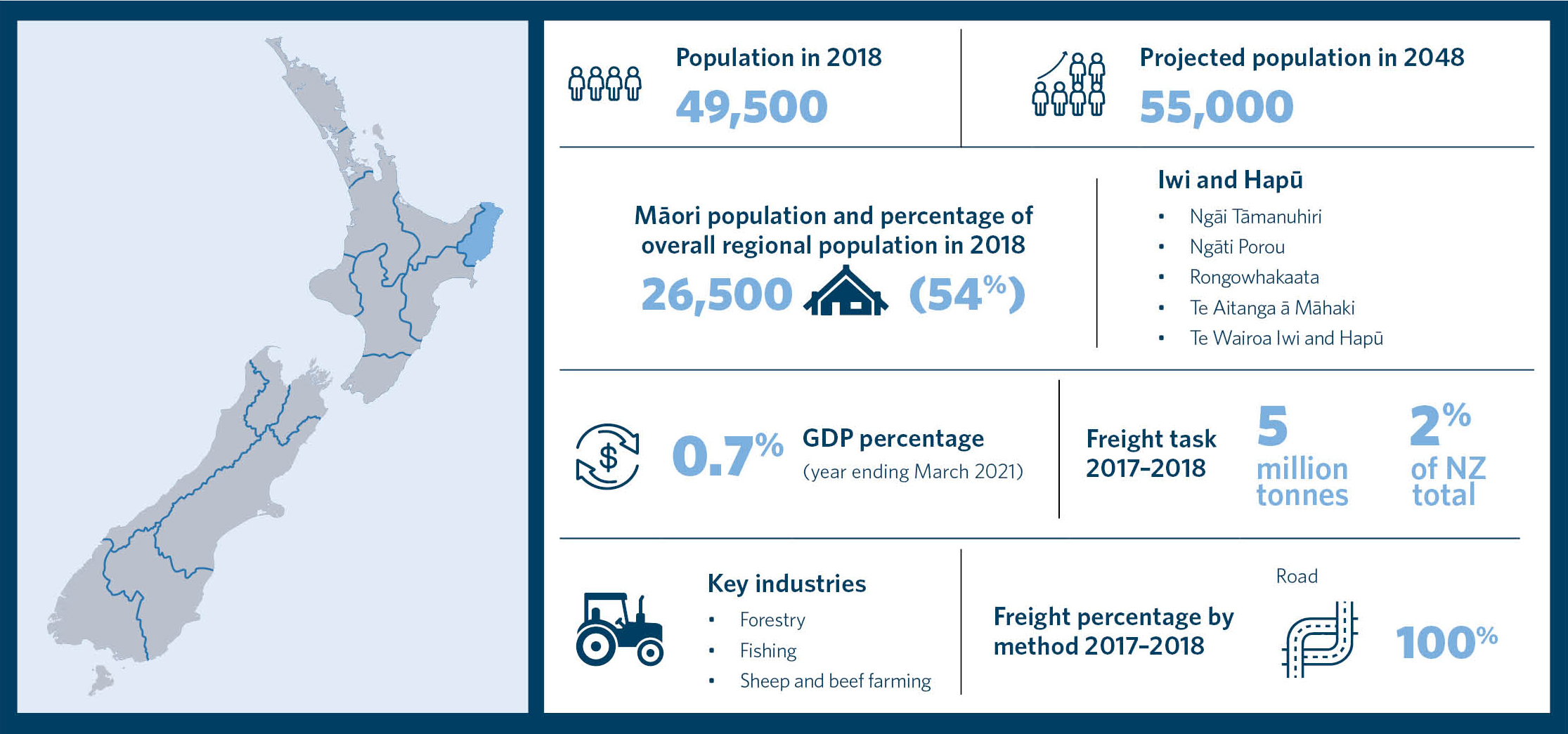At a glance

Arataki Tairāwhiti – Gisborne regional direction [PDF, 15 MB]
Arataki Tairāwhiti statistics table – infographic alternative [PDF, 115 KB]
The September 2023 v1.1 release of Arataki includes updates to reflect the severe weather events of 2023 and make minor corrections. Most sections of the Arataki Tairāwhiti – Gisborne regional direction have climate-related updates.
Tairāwhiti Gisborne is one of the most remote regions in Aotearoa New Zealand and home to about 1% of the country’s population. The economy is largely based on primary production, forestry, fishing, sheep and beef farming, horticulture, and viticulture.
The region is highly dependent on SH35 and SH2. Both highways have resilience challenges with no alternate routes. The reliability of these corridors is critical.
The region’s population is forecast to grow from 49,500 to about 55,000 by 2048. Transport can support regional development by:
- improving access to employment, education, training, and essential services for remote East Cape communities
- enabling the movement of goods to Eastland Port and access to visitor destinations
- ensuring safe and reliable connections to neighbouring regions.
Challenging terrain and long distances result in relatively long travel times. Of the region’s 1,889kms of local roads, 37% are unsealed.
Tairāwhiti has limited public transport services. Around 90% of trips to work are by private vehicle. Active modes are likely the best way to reduce vehicle kilometres travelled, along with increasing the share of freight moved by coastal shipping. The region has higher than average rates of walking and cycling, but numbers are declining. Investment in safe and easy ways to access facilities can help shift more people to active modes.
Focusing our efforts
For efficient and effective progress, transport challenges in Tairāwhiti Gisborne must be tackled in a cohesive way. The directions below identify the most important issues to be resolved over the next 10 years to make progress towards transport outcomes.
- Rebuild the network destroyed by Cyclone Gabrielle and improve resilience.
- Enable and support the region’s transition to a low-carbon economy.
- Maintain and improve the resilience and efficiency of key connections to the west and south.
- Improve access to social and economic opportunities, especially by public transport, walking, and cycling.
- Begin to reduce vehicle kilometres travelled in a way that’s equitable and improves people’s quality of life.
- Significantly reduce the harm caused by the region’s transport system, especially through improved road safety and reduced pollutants dangerous to health.
- Actively support, enable, and encourage growth and development in areas that already have good travel choices and shorter trip lengths.
- Rapidly accelerate the delivery of walking and cycling networks, predominantly through reshaping existing streets, to make these options safe and attractive.
- Explore new and emerging technologies, such as on-demand services, to improve access to social and economic opportunities.
- Better understand the impact of future economic transformation on travel patterns and freight volumes.
- Explore opportunities to move to a more multimodal freight system with greater use of rail and coastal shipping.
- Confirm how key resilience risks will be addressed over time, and work with communities to identify plans for when to defend, accommodate, or retreat.
- Continue to implement road safety plans and programmes including those focused on iwi Māori.
- Reduce financial and other barriers to iwi Māori getting a driver’s licence in areas not well served by public transport.
- Improve or maintain, as appropriate, physical access to marae, papakāinga, wāhi tapu, and wāhi taonga.
These will be updated over time to focus effort on the most critical matters.
Arataki Tairāwhiti – Gisborne regional direction [PDF, 15 MB]
